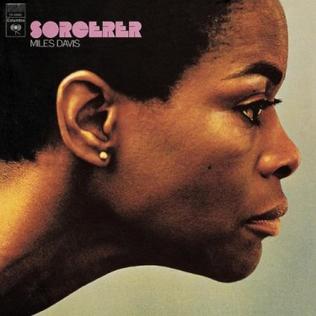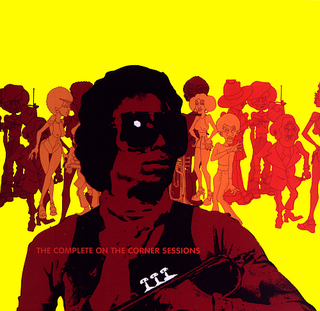
Miles Dewey Davis III was an American jazz trumpeter, bandleader, and composer. He is among the most influential and acclaimed figures in the history of jazz and 20th-century music. Davis adopted a variety of musical directions in a roughly five-decade career that kept him at the forefront of many major stylistic developments in jazz.

Bitches Brew is a studio album by the American jazz trumpeter, composer, and bandleader Miles Davis. It was recorded from August 19 to 21, 1969, at Columbia's Studio B in New York City and released on March 30, 1970, by Columbia Records. It marked his continuing experimentation with electric instruments that he had featured on his previous record, the critically acclaimed In a Silent Way (1969). With these instruments, such as the electric piano and guitar, Davis departed from traditional jazz rhythms in favor of loose, rock-influenced arrangements based on improvisation. The final tracks were edited and pieced together by producer Teo Macero.

Sorcerer is an album by the jazz trumpeter and composer Miles Davis. It is the third of six albums that his 1960s quintet recorded. It also includes one track from a 1962 session with vocalist Bob Dorough, which was the first time Wayne Shorter recorded with Davis. Davis does not play on the second track, "Pee Wee". The album's cover is a profile photo of actress Cicely Tyson, who at the time was Davis's girlfriend.

Nefertiti is a studio album by the jazz trumpeter and composer Miles Davis. It was released in March 1968 through Columbia Records. The recording was made at Columbia's 30th Street Studio over four dates between June 7 and July 19, 1967, the album was Davis' last fully acoustic album. Davis himself did not contribute any compositions – three were written by tenor saxophonist Wayne Shorter, two by pianist Herbie Hancock, and one by drummer Tony Williams.

Jack Johnson is a studio album and soundtrack by the American jazz trumpeter, composer, and bandleader Miles Davis. It was released on February 24, 1971, by Columbia Records.

On the Corner is a studio album by the American jazz trumpeter, bandleader, and composer Miles Davis. It was recorded in June and July 1972 and released on October 11 of that year by Columbia Records. The album continued Davis' exploration of jazz fusion, and explicitly drew on the influence of funk musicians Sly Stone and James Brown, the experimental music of Karlheinz Stockhausen, the free jazz of Ornette Coleman, and the work of collaborator Paul Buckmaster.

Get Up with It is an album by American jazz musician Miles Davis. Released by Columbia Records on November 22, 1974, it collected previously unreleased material that Davis had recorded between 1970 and 1974, some of which dated from the sessions for his studio albums Jack Johnson (1971) and On the Corner (1972).

Big Fun is an album by American jazz trumpeter Miles Davis. It was released by Columbia Records on April 19, 1974, and compiled recordings Davis had made in sessions between 1969 and 1972. It was advertised as a new album with "four new Miles Davis compositions" One of three Davis albums released in 1974 and largely ignored, it was reissued on August 1, 2000, by Columbia and Legacy Records with additional material, which led to a critical reevaluation.

Tutu is an album by jazz trumpeter Miles Davis, released in 1986 by Warner Bros. Records. The album is Miles Davis' tribute to Archbishop Desmond Tutu who was a human rights and anti-apartheid activist. It was recorded primarily at Capitol Studios in Los Angeles and Clinton Recording in New York, except the song "Backyard Ritual", which was recorded at Le Gonks in West Hollywood. Davis received the 1986 Best Jazz Instrumental Performance, Soloist Grammy Award for his performance on the album.

The Complete Bitches Brew Sessions is a four-disc box set by jazz trumpeter Miles Davis compiling recordings between August 19, 1969, and February 6, 1970—including the 1970 double album Bitches Brew in its entirety—and released on Columbia/Legacy on November 24, 1998.
Reginald Grant Lucas was an American guitarist, songwriter and record producer. Lucas is perhaps best known for producing the majority of Madonna's 1983 self-titled debut album, and for playing rhythm guitar with the Miles Davis electric band during the first half of the 1970s.

Agharta is a 1975 live double album by American jazz trumpeter, composer, and bandleader Miles Davis. By the time he recorded the album, Davis was 48 years old and had alienated many in the jazz community while attracting younger rock audiences with his radical electric fusion music. After experimenting with different line-ups, he established a stable live band in 1973 and toured constantly for the next two years, despite physical pain from worsening health and emotional instability brought on by substance abuse. During a three-week tour of Japan in 1975, the trumpeter performed two concerts at the Festival Hall in Osaka on February 1; the afternoon show produced Agharta, and the evening show was released as Pangaea the following year.

Peter Palus Cosey was an American guitarist who played with Miles Davis' band between 1973 and 1975. His fiercely flanged and distorted guitar invited comparisons to Jimi Hendrix. Cosey kept a low profile for much of his career and released no solo recorded works. He appeared on Davis's albums Get Up with It (1974), Agharta (1975), Pangaea (1976), Dark Magus (1977), and The Complete On the Corner Sessions (2007).

Miles Davis at Fillmore is a 1970 live album by the jazz trumpeter Miles Davis and band, recorded at the Fillmore East, New York City on four consecutive days, June 17 through June 20, 1970, originally released as a double vinyl LP. The performances featured the double keyboard set-up Davis toured with for a few months, with Keith Jarrett and Chick Corea playing electronic organ and Fender Rhodes electric piano, respectively. The group opened for Laura Nyro at these performances.

Black Beauty: Miles Davis at Fillmore West is a live double album by the American jazz trumpeter, composer, and bandleader Miles Davis. It was recorded on April 10, 1970, at the Fillmore West in San Francisco, shortly after the release of the trumpeter's Bitches Brew album and the recording of Jack Johnson (1971). Black Beauty was produced by Teo Macero, Davis' longtime record producer. A jazz-rock and fusion album, Black Beauty captured one of Davis' first performances at a rock venue during the early stages of his electric period. At the concert, he led his band—saxophonist Steve Grossman, bassist Dave Holland, keyboardist Chick Corea, drummer Jack DeJohnette, and percussionist Airto Moreira—through one continuously performed set list which functioned as a musical suite for soloists to improvise throughout. He signaled changes from one piece to the next with phrases played on his trumpet.

Circle in the Round is a 1979 compilation album by jazz musician Miles Davis. It compiled outtakes from sessions across fifteen years of Davis's career that, with one exception, had been previously unreleased. All of its tracks have since been made available on album reissues and box sets.

In Concert is a live double album by the American jazz musician Miles Davis. It was recorded in 1972 at the Philharmonic Hall in New York City. Columbia Records' original release did not credit any personnel, recording date, or track listing, apart from the inner liner listing the two titles "Foot Fooler" and "Slickaphonics."

The Complete On the Corner Sessions is a posthumous box set by American jazz musician Miles Davis, released in the US on September 25, 2007, by Columbia Records and in the UK on September 29 on Legacy Recordings. Like other Davis box sets, the included material is taken from a wider chronology of sessions than the dates which actually produced the titular album. The Complete On the Corner Sessions compiles material from 1972 through 1975 which, due to lineup changes Davis made throughout the era, features over two dozen musicians.

Dark Magus is a live double album by the American jazz trumpeter, composer, and bandleader Miles Davis. It was recorded on March 30, 1974, at Carnegie Hall in New York City, during the electric period in Davis' career. His group at the time included bassist Michael Henderson, drummer Al Foster, percussionist Mtume, saxophonist Dave Liebman, and guitarists Pete Cosey and Reggie Lucas; Davis used the performance to audition saxophonist Azar Lawrence and guitarist Dominique Gaumont. Dark Magus was produced by Teo Macero and featured four two-part recordings, titled with the Swahili numerals for numbers one through four.

Panthalassa: The Music of Miles Davis 1969–1974 is a remix album of recordings by Miles Davis, released on February 16, 1998, by Sony Records. It contains compositions from prior albums, including In a Silent Way (1969), On the Corner (1972), and Get Up With It (1974), remixed by Bill Laswell; it is subtitled "Reconstruction and Mix Translation by Bill Laswell". The album was composed as a dark, continuous tone poem divided by four sections of Davis' jazz fusion recordings. Panthalassa received generally positive reviews from music critics and sold well, charting at number four on the Billboard Top Jazz Albums.



















